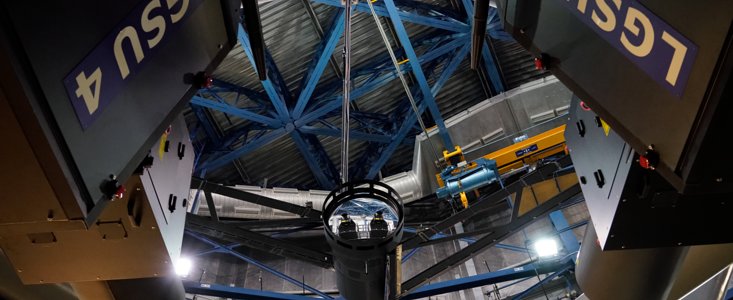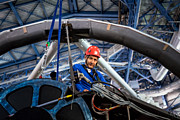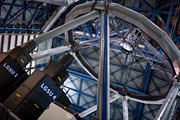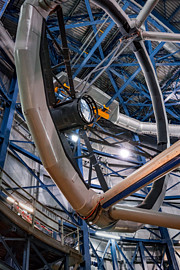Meddelelse
First Light for Largest Adaptive Optics System
VLT Unit Telescope 4 takes a key step towards being fully adaptive
28. oktober 2016
A major milestone has been reached in the project to transform Unit Telescope 4 (Yepun) of ESO’s Very Large Telescope (VLT) into a fully adaptive telescope, with the installation of a deformable secondary mirror on the telescope.
Adaptive Optics systems compensate for the blurring effect of the Earth’s atmosphere that degrades the sharpness of images that can be obtained with a telescope — even a very large and sophisticated one like the VLT. The installation of the new Adaptive Optics Facility (AOF) as an integral part of UT4 will enable the telescope to obtain even sharper images.
The deformable secondary mirror consists of a 1.96 mm-thick flexible mirror sitting on a mount that holds 1170 actuators which change the shape of the mirror to correct for the effect of turbulence in the atmosphere. At just over one metre in diameter, this is the largest adaptive optics mirror ever produced. The deformable mirror has demanded cutting-edge technology, and its development journey began several years ago. Construction of the “reference optic” — essentially the mirror support — was completed in 2010, and the first version of the thin mirror itself was delivered to ESO’s Headquarters in Garching at the end of 2011, followed by an improved version in 2014. After extensive performance testing In Garching, the deformable secondary mirror assembly was shipped to Chile and has now been mounted on the 8.2-metre diameter Yepun.
Optical alignment and other tests have recently been performed with the deformable mirror — set in rigid mode — mounted on the telescope, and it has passed with flying colours.
In addition to replacing the telescope’s conventional secondary mirror with this new deformable mirror, the AOF system also includes the Four Laser Guide Star Facility (4LGSF), which saw first light in April 2016, and the installation of adaptive optics (AO) modules at the various foci of the secondary mirror. The AO modules are GRAAL (GRound layer Adaptive optics Assisted by Lasers), that feeds corrected images into HAWK-I, and GALACSI (Ground Atmospheric Layer Adaptive Corrector for Spectroscopic Imaging), which pre-filters images for the MUSE spectrograph.
Other tools to optimise the operation of the AOF have been developed and are now operational. These include the Astronomical Site Monitor software that monitors the atmosphere to determine the altitude at which the turbulence is occurring, and the Laser Traffic Control system that prevents the 4LGSF beams from interfering with aeroplanes or telescopes in space.
With the advent of the AOF system, the VLT will continue to extend its list of world-class scientific results and experience with the system at Paranal will contribute to overcoming the technical challenges presented by ESO’s next major project, building the European Extremely Large Telescope.
Links
Kontakter
Elise Vernet
ESO
Garching bei München, Germany
Tel: +49 89 3200 6322
Email: evernet@eso.org
Robin Arsenault
ESO
Garching bei München, Germany
Tel: +49 89 3200 6524
Email: rarsenau@eso.org
Peter Grimley
ESO, Assistant Public Information Officer
Garching bei München, Germany
Tel: +49 89 3200 6383
Email: pgrimley@eso.org
Om meddelelsen
| Id: | ann16078 |
Our use of Cookies
We use cookies that are essential for accessing our websites and using our services. We also use cookies to analyse, measure and improve our websites’ performance, to enable content sharing via social media and to display media content hosted on third-party platforms.
ESO Cookies Policy
The European Organisation for Astronomical Research in the Southern Hemisphere (ESO) is the pre-eminent intergovernmental science and technology organisation in astronomy. It carries out an ambitious programme focused on the design, construction and operation of powerful ground-based observing facilities for astronomy.
This Cookies Policy is intended to provide clarity by outlining the cookies used on the ESO public websites, their functions, the options you have for controlling them, and the ways you can contact us for additional details.
What are cookies?
Cookies are small pieces of data stored on your device by websites you visit. They serve various purposes, such as remembering login credentials and preferences and enhance your browsing experience.
Categories of cookies we use
Essential cookies (always active): These cookies are strictly necessary for the proper functioning of our website. Without these cookies, the website cannot operate correctly, and certain services, such as logging in or accessing secure areas, may not be available; because they are essential for the website’s operation, they cannot be disabled.
Functional Cookies: These cookies enhance your browsing experience by enabling additional features and personalization, such as remembering your preferences and settings. While not strictly necessary for the website to function, they improve usability and convenience; these cookies are only placed if you provide your consent.
Analytics cookies: These cookies collect information about how visitors interact with our website, such as which pages are visited most often and how users navigate the site. This data helps us improve website performance, optimize content, and enhance the user experience; these cookies are only placed if you provide your consent. We use the following analytics cookies.
Matomo Cookies:
This website uses Matomo (formerly Piwik), an open source software which enables the statistical analysis of website visits. Matomo uses cookies (text files) which are saved on your computer and which allow us to analyze how you use our website. The website user information generated by the cookies will only be saved on the servers of our IT Department. We use this information to analyze www.eso.org visits and to prepare reports on website activities. These data will not be disclosed to third parties.
On behalf of ESO, Matomo will use this information for the purpose of evaluating your use of the website, compiling reports on website activity and providing other services relating to website activity and internet usage.
Matomo cookies settings:
Additional Third-party cookies on ESO websites: some of our pages display content from external providers, e.g. YouTube.
Such third-party services are outside of ESO control and may, at any time, change their terms of service, use of cookies, etc.
YouTube: Some videos on the ESO website are embedded from ESO’s official YouTube channel. We have enabled YouTube’s privacy-enhanced mode, meaning that no cookies are set unless the user actively clicks on the video to play it. Additionally, in this mode, YouTube does not store any personally identifiable cookie data for embedded video playbacks. For more details, please refer to YouTube’s embedding videos information page.
Cookies can also be classified based on the following elements.
Regarding the domain, there are:
- First-party cookies, set by the website you are currently visiting. They are stored by the same domain that you are browsing and are used to enhance your experience on that site;
- Third-party cookies, set by a domain other than the one you are currently visiting.
As for their duration, cookies can be:
- Browser-session cookies, which are deleted when the user closes the browser;
- Stored cookies, which stay on the user's device for a predetermined period of time.
How to manage cookies
Cookie settings: You can modify your cookie choices for the ESO webpages at any time by clicking on the link Cookie settings at the bottom of any page.
In your browser: If you wish to delete cookies or instruct your browser to delete or block cookies by default, please visit the help pages of your browser:
Please be aware that if you delete or decline cookies, certain functionalities of our website may be not be available and your browsing experience may be affected.
You can set most browsers to prevent any cookies being placed on your device, but you may then have to manually adjust some preferences every time you visit a site/page. And some services and functionalities may not work properly at all (e.g. profile logging-in, shop check out).
Updates to the ESO Cookies Policy
The ESO Cookies Policy may be subject to future updates, which will be made available on this page.
Additional information
For any queries related to cookies, please contact: pdprATesoDOTorg.
As ESO public webpages are managed by our Department of Communication, your questions will be dealt with the support of the said Department.





